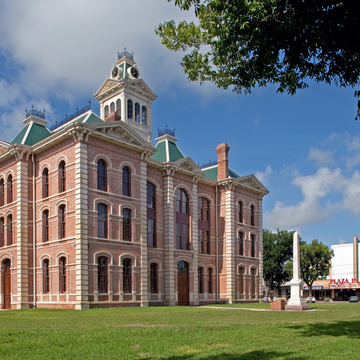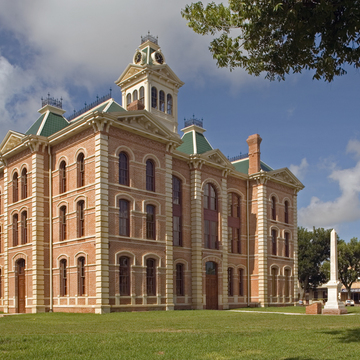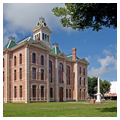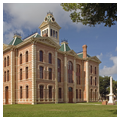Heiner designed the 1889 replacement for Wharton's prior courthouse of 1852. Although not as ambitious as Heiner's courthouses in neighboring Colorado ( PF46) and Lavaca ( SF19) counties, the courthouse is the cornerstone of downtown Wharton. When it was to be built, W. J. Croom, county judge, led a crew in vandalizing the 1852 courthouse to blunt the opposition of county ranchers Green C. Duncan and A. H. Pierce, who feared county tax rates would be raised to pay for a new building, a controversy that reflected the same sorts of tensions manifest in the Jay Bird–Woodpecker War next door in Fort Bend County (see AS30) . Croom and other white county officials had been elected with the support of the county's African American majority (80 percent of Wharton County's population in 1890). Upon completion, the courthouse was where the White Man's Union Association was formed in November 1889, which led to the exclusion of African Americans from local politics. R. H. Tisdale and A. H. Speaker, county commissioners whose names appear on the cornerstone, were two of Wharton County's last black officials.
In 1935, county commissioners had Houston architect J. W. Dehnert remove the mansard roofs and central tower. Dehnert added one-story wings to the S. Fulton and S. Houston streets sides of the courthouse; a subsequent pair of one-story wings were added to the W. Milam and W. Burleson streets sides in 1949. In the late 1990s, the Wharton County Historical Commission, with the support of Wharton painting contractor David C. Bucek and his son, Houston architect David C. Bucek Jr., successfully advocated for preservation and restoration of the courthouse. Under the direction of Bailey Architects of Houston and with funding from the Texas Historic Courthouse Preservation Program, the 1930s and 1940s alterations were removed, the exterior brick walls and Austin limestone trim restored, and the mansard roofs and central tower reconstructed, along with the courthouse's interiors, in 2007.
Of several monuments in Monterey Square, the most impressive is the granite and marble Hamilton B. Dickson Monument, erected in 1894 in memory of a county sheriff shot while pursuing an escaped murderer. Jaeggli and Martin of Brenham were the sculptors.


















